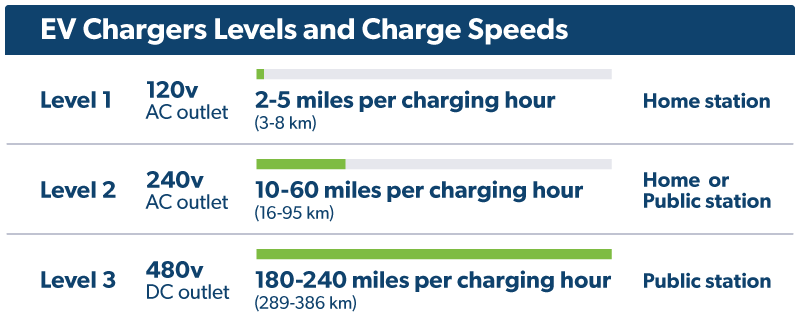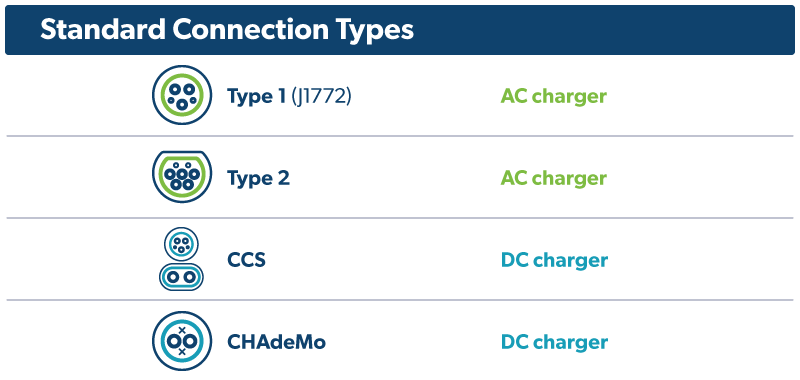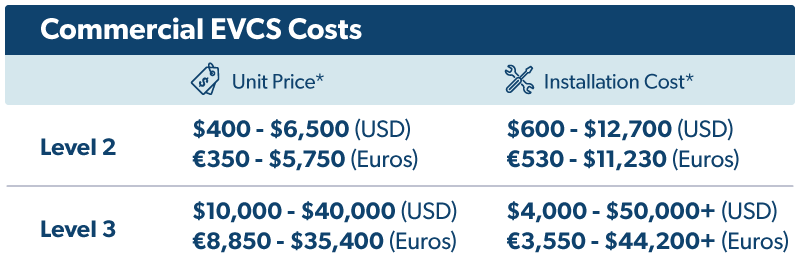Electric vehicles and fleets are here to stay. In the United States alone, automotive manufacturers estimate that electric vehicles (EV) will account for 40%-50% of new sales by 2030. Are you ready to meet the challenge and seize the opportunity?
With more electric vehicles hitting the road, owners will need a reliable network of EV charging stations to keep them going. Facility owners and operators can become part of the vital network and turn the opportunity into a competitive advantage. So, where do you begin? Let’s walk through some basics.
1. EV charger types and levels. What should you install at your facility?
EV charging stations range in voltage and speed. Connectors also vary by region and manufacturer. We outline below key facts for your information:

Level 1 chargers:
Level 1 chargers, commonly used by homeowners, charge electric vehicles over several hours. While homeowners can purchase level 2 chargers, these chargers are widely used at public charging stations. Level 3 chargers, also known as DC fast chargers, are for commercial applications and require specific technical skills for successful installations.
That’s not all there is to know about EV charging. EV manufacturers use different charger connectors. There are four standard connector types:

Then there is Tesla
Tesla vehicles are equipped with a connector compatible with Tesla-specific chargers, Levels 1, 2, and 3. Tesla drivers can also use a J1772 charging adapter to connect to most Level 2 public charging stations.
Note: Since Level 1 chargers have the lowest volt output, most businesses install Level 2 or Level 3 chargers.
2. What is the cost of EV charger installation?
There is a massive range in charging stations’ unit and installation costs for commercial EV chargers. When evaluating the value of adding EV charging stations to your facility, keep in mind that these stations are a long-term investment.

3. How many EV charging stations should you install at your facility?
There isn’t an exact formula to decide the number of charging station units your company should invest in. However, there are at least four key factors to consider:
- The total parking spaces available
- Your building’s utility capacity
- Who will be the primary user of your charging stations: customers or employees?
- Tax incentives available for EV charging stations installation
Research the number of EVs registered in your city or state. It is more likely that a customer drives an EV in California than in Wyoming. The dependence on public chargers is higher in California. However, the scarcity of charging stations in areas with lower numbers of EVs will help draw in more EV owners as potential customers.
Your building’s utility capacity will dictate the right strategy for your specific use case. Consider adding solar-powered EV charging stations to your mix. A specialized consultant can help you assess your specific needs and craft a sustainable plan.
And, of course, stay up to date with tax incentives and government programs. With the heightened emphasis on the need for clean energy and the infrastructure bill, you might find opportunities to help finance your capital investment.
4. What are the benefits of installing public EV charging stations?
Lead the way: Environmental stewardship can fuel your growth
In 2021, customers care about a company’s stances on matters like sustainability. This concern includes a business’s ecological footprint. A 2017 Forbes report supports this shift in consumers’ mindsets. Eighty-eight percent of customers are more likely to remain loyal to a ‘green’ company than a less eco-conscious competitor. What do your customers care about? Are you prepared to show how you are leading the way to a greener future?
Put your business on the map
Installing EV charging stations at your facility literally puts you on all the maps for public EV charger locations. Customers can locate your business as a place to spend time and shop while their vehicles charge. Since EV charging stations are not as common as gas stations, your location will stand out to EV drivers who plan their trips around EV charging station availability.
Reach new customers and employees
Offering access to EV charging stations means opening your doors to a new pool of customers. The same can be true for attracting talent. While the competition for talent intensifies across industries, many employers opt to up the ante in their benefits by outfitting their facilities with EV charging stations.
Receive Tax Incentives
Take advantage of the tax breaks and incentives available for companies investing in EV charging stations. In 2021, U.S. lawmakers are looking to expand EV infrastructure opportunities with the now approved bipartisan infrastructure bill.
In addition, businesses that receive Leadership in Energy and Environmental Design (LEED) certification for their buildings are eligible for tax credits, zoning allowances, reduced fees, and expedited permitting from several U.S. government agencies. The LEED certification is a green building certification program used worldwide.
5. What are the first steps in EV charging purchasing and installation?
So, you’ve made up your mind and are ready to start the exciting yet daunting journey of EV charging station purchasing and installation for your facility. Here are a few questions from our pros to get you pointed in the right direction:
- What utility upgrades, if any, will your site require?
- Should you consider adding solar-powered stations to your mix?
- What type of EV charging stations do you want to purchase?
- What financial incentives are available in your region?
- How many EV charging stations should you install?
- What will your maintenance and repair plan look like?
Our advice? Ask a professional. Our SEAM Group team of experts offers a variety of solutions to people in your exact situation. From commissioning and repairs to consulting and management services, you can rely on a team dedicated to making the world a safer, more reliable place.
Learn more about the EVCS installation and maintenance services our team can provide you.